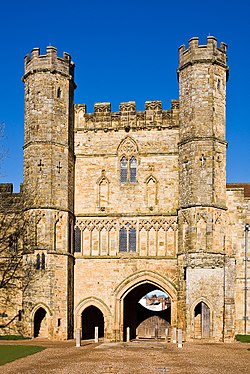Battle Abbey
| Battle Abbey | |
|
Sussex | |
|---|---|
 Battle Abbey - Gate House | |
| Location | |
| Grid reference: | TQ748157 |
| Location: | 50°54’51"N, -0°29’12"E |
| Village: | Battle |
| Order: | Benedictine |
| History | |
| Established: | 1070 |
| Founder: | King William I |
| Information | |
| Condition: | Part ruin, part in use |
| Owned by: | English Heritage |
| Website: | 1066 Battle of Hastings, Abbey and Battlefield |
Battle Abbey in Sussex was built by William the Conqueror to give thanks on the site of his victory at the Battle of Hastings in 1066, hence its name. Around it grew the village of Battle. Today the Abbey is in partially ruin.
The abbey in its day was a Benedictine foundation and was dedicated to St Martin of Tours, patron saint of soldiers. Current research has called this site into question and ongoing research is being done to discover the actual battle site.[2]
The site today is operated by English Heritage as "1066 Battle of Hastings, Abbey and Battlefield", which site includes the abbey buildings and ruins, a visitor centre with a film and exhibition about the battle, audio tours of the battlefield site, and the monks' gatehouse with recovered artefacts. The visitor centre includes a children's discovery room and a café, and there is an outdoor themed playground.

History
In 1070 Pope Alexander II ordered the Normans to do penance for killing so many people during their conquest of England. In response, William the Conqueror vowed to build an abbey where the Battle of Hastings had taken place, with the high altar of its church on the supposed spot where King Harold fell in that battle on Saturday, 14 October 1066. He started building it, dedicating it to St Martin, sometimes known as "the Apostle of the Gauls," though William died before it was completed. Its church was finished in about 1094 and consecrated during the reign of his son William II Rufus. William I had ruled that the Church of St Martin of Battle was to be exempted from all episcopal jurisdiction but that of the Archbishop of Canterbury.
The abbey was remodelled in the late 13th century and throve until the Dissolution of the Monasteries in 1538 under King Henry VIII.

At the Dissolution, the displaced monks of Battle Abbey were provided with pensions, including the abbot John Hamond and the prior Richard Salesherst, as well as monks John Henfelde, William Ambrose, Thomas Bede and Thomas Levett, all bachelors in theology.

The abbey and much of its land was given by Henry VIII to his friend and Master of the Horse, Sir Anthony Browne, who demolished the church and parts of the cloister and turned the abbot’s quarters into a country house. In 1721 the abbey was sold by Browne's descendant, Anthony Browne, 6th Earl of Montagu, to Sir Thomas Webster, MP and baronet. Sir Thomas had married the heiress Jane Cheek, granddaughter of a wealthy merchant, Henry Whistler, to whose vast inheritance she succeeded in 1719. Webster was succeeded by his son, Sir Whistler Webster, 2nd Baronet, who died childless in 1779, being succeeded in the baronetcy by his brother. Battle Abbey remained in the Webster family until 1858, when it was sold by the sixth baronet, who died in 1853, to Lord Harry Vane, later Duke of Cleveland. On the death of the Duchess of Cleveland in 1901, the estate was bought back by Sir Augustus Webster, 7th baronet.
The house was an all-girls boarding school when Canadian troops were stationed there during the Second World War (the girls' having moved out for the duration, thankfully), and it resumed its role as a school after the war, as it continues to this day.
The descendants of Sir Augustus Webster sold Battle Abbey to the government in 1976 and it is now in the care of English Heritage.


All that is left of the abbey church itself today is its outline on the ground, but parts of some of the abbey's buildings are still standing: those built between the 13th and 16th century. These are still in use as the independent Battle Abbey School.[1] Visitors to the abbey usually are not allowed inside the school buildings, although during the school's summer holidays, access to the abbot's hall is often allowed.
The church's high altar reputedly stood on the spot where Harold died. This is now marked by a plaque on the ground, and nearby is a monument to Harold erected by the people of Normandy in 1903. The ruins of the abbey, with the adjacent battlefield, are a popular tourist attraction, with events such as the Battle of Hastings reenactments.
Outside links
| ("Wikimedia Commons" has material about Battle Abbey) |
- 1066 Battle of Hastings, Abbey and Battlefield - English Heritage
- National Monuments Record: No. 414519 – Battle Abbey
- [1]
- Battle Abbey and Town
- Battle Abbey School
References
- ↑ "Battle Abbey". Records of Early English Drama. http://link.library.utoronto.ca/reed/venue.cfm?VenueListID=383. Retrieved 2008-10-13.